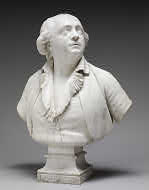
|
Jean-Antoine Houdon (artist) French, 1741 - 1828 Giuseppe Balsamo, Comte di Cagliostro, 1786 marble Overall (without base): 62.9 x 58.9 x 34.3 cm (24 3/4 x 23 3/16 x 13 1/2 in.) gross weight: 285 lb. (129.275 kg) Samuel H. Kress Collection 1952.5.103 |
Object 1 of 7
One of his contemporaries noted that Houdon, the most successful portrait sculptor of his day, "pushed truth to the bitter end." This bust captures the fleshy and disheveled scoundrel Cagliostro, who bilked the courts of Europe as an alchemist and mesmerizer. He was implicated in the notorious Affair of the Diamond Necklace, which galvanized public opinion against the French royal family when it appeared that Marie-Antoinette had purchased an extravagant necklace at a time of strained public finances. In fact, an ambitious dupe had made the purchase in hopes of currying the queen's favor. Cagliostro was suspected of acting as a go-between, and though no charges were proven, he was expelled from France in 1786, the same year this bust is dated. He died in a prison in Rome about fifteen years later, condemned by the pope as a heretic.
Cagliostro's spirited portrait contrasts with Houdon's cool and impersonal Diana. Cagliostro's eyes, for example, are drilled to indicate the pupil, whereas Diana's blank, undifferentiated gaze reveals neither spirit nor human emotion. Houdon copied Diana from his 1776 plaster model for a full-length statue, a practice he followed frequently.
| « | back to gallery | » | continue tour |


